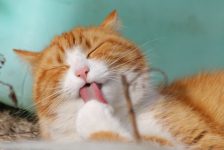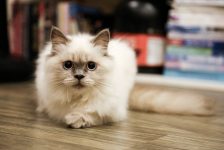The average lifespan of pet cats has risen in recent years to 15 years of age, but according to some statistics strictly indoor cats can live to 20 years or more, which is a longer life than cats who are allowed to roam freely, or are kept as indoor-outdoor cats.
The reason for this varies but generally it is because keeping cats indoors limits the likelihood of them becoming hurt or sick from outside factors like parasites, illnesses, or getting run over by cars.
However, simply keeping your cat inside is not enough to ensure that it is living the highest quality of life. Here are some things you can do to greatly improve your cat’s indoor life:
1. Set aside some time to bond with your cat
Cats can find ways to entertain themselves. Considering that they sleep most of the day, (cats sleep 16 hours on average daily), most people end up neglecting their need for mental stimulation and exercise.
The amount of exercise they need is dependent on their breed, but 30 minutes of play time per day should be enough for most cats. Kittens, with their abundance of energy, might need more play time than adult cats.
Playtime is also a good way to strengthen the bond between you and your pet cat. Toys such as laser pointers and feathers are excellent in this aspect.
If you can, also provide your cat with vertical spaces such as high shelves where they can climb and entertain themselves while you are gone.
If you have issues with your cat being destructive remember that a tired cat is less likely to destroy your things as it has spent its excess energy during playtime.
Another good way to bond with your cat is through grooming. Cats can groom themselves, so they don’t need regular baths like dogs do. However, it is still important to occasionally assist them in grooming so they do not catch fleas and ticks. Cats also groom each other as a sign of affection and protection. Seeing as cats see us humans as nothing but big furless cats, helping them groom will also improve your bond with them.
However, don’t forget that cats, like humans, need their alone time as well. While it’s good to bond with kitty, it’s important that you respect their privacy. Balance is key.
2. Always keep their litter box clean
Cats hate dirty toilets as much as humans do, so always make sure that you clean their litter box or boxes. It is recommended that you keep more than one if you have a bigger place. Cats may get put off by a dirty litter box; in such a situation they might hold their urine or faeces in, which might cause your kitty to have accidents or contract a UTI (urinary tract infection).
Frequently dirty litter boxes also encourage pet cats to do their business elsewhere in the house, which is harder to clean and unsanitary for both you and your pet. This might also cause problems for you as cat faeces may have parasites such as Toxoplasma gondii (the parasite that causes toxoplasmosis in humans).
To avoid problems and ensure a sanitary environment at home, clean your cat’s litter box at least once a day.
3. Take them to the vet regularly
For us humans, it is recommended that we see a doctor for a routine check-up at least once a year to make sure that everything is fine and that we’re healthy.
This goes the same for cats. Cats often hide their pain and spend most of their time sleeping, so it can be hard to tell if your cat is feeling unwell. To ensure that they are healthy and living the best quality of life possible, a regular trip to their veterinarian is a must.
If your cat does have an illness, regular vet visits will help it get caught on time and will help your cat get the best treatment possible.
Getting their vaccinations up to date through regular vet consultations will also prevent some of the most common illnesses a cat can get. These include rabies, feline leukaemia, and feline distemper.
To ensure that your beloved pet stays with you for a long time, make sure they see their veterinarian regularly.
4. Feed them at regular intervals and avoid free feeding
Free feeding is when you fill their bowl for them to eat whenever they wish. This is usually done partly for the owner’s convenience as they don’t have to worry about when to feed their pets or if their pets are getting fed.
However, this is not ideal. If your cat’s food intake isn’t properly monitored, especially if they’re an indoor cat whose space for physical activity is limited, they are at risk of obesity.
It is recommended that you feed them at regular intervals, preferably on a schedule. Once or twice a day is enough to avoid your cat gaining too much weight. Programmable electronic feeders are also available.
Feeding them high-quality food will also ensure a better quality of life for your cat. It costs more but it also has more benefits. For one thing, it will lessen the need to feed your cat every few hours as most high-quality foods are made of mostly meat and will keep them satiated for most of the day. It will also lessen the likelihood of your cat developing illnesses from eating low-quality food that contain too much salt and fillers.
Improving your cat’s food and feeding time will also improve your cat’s quality of life.
5. Always make clean water available
If you are feeding your cat only dry food, make sure there is always a bowl of clean water for them to drink from. Dry food only contains 10 per cent water and cats need to drink 2 – 4 ounces of water daily. Not making sure of this may cause your cat to become dehydrated, especially in the warmer months since a lot of cats don’t drink as much as they should.
Consider using a water fountain as most cats prefer running water to stagnant water in a bowl. Therefore, a lot of them move their bowl before drinking as this recreates that effect. Another possible reason for them preferring running water is because they have trouble correctly gauging the water level in the bowl if it is stagnant.
A water fountain also makes sure your kitty gets their required ounces of water without the waste of leaving your faucet running.
Looking after an indoor cat is easy
So, as you can see, it doesn’t take much to improve the life of your indoor cat as they are independent by nature. However, a little time and effort goes a long way towards ensuring your beloved feline friend has the best indoor life possible.





